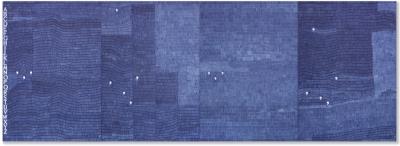Alighiero Boetti *

(Torino 1940–1994 Rome)
Non parto non resto, c. 1981, signed on the reverse of the first element, blue ballpoint pen on paper, four elements, 102 x 288 cm (overall dimension), 102 x 72 cm (each element), in plexiglass boxes
This work is registered in the Archivio Alighiero Boetti, Rome and is accompanied by a photo certificate of authenticity
Provenance:
Tornabuoni Arte, Florence
European Private Collection
Exhibited:
Paris, Alighiero Boetti, Tornabuoni Art, March-June 2010, exh. cat. pp. 100–111 with ill.
Literature:
J.C. Ammann (ed.), Alighiero Boetti Catalogo generale, Electa, Milan, 2015, vol. III/1, p. 136, no. 1371 with ill.
Alighiero Boetti often took up contradictory positions during his lifetime, which prompted the art historian Achille Bonito Oliva on the recent occasion of a retrospective at the MAXXI Museum in Rome to describe him as a complex, chameleon-like character and fine intellectual. Boetti’s divisiveness is expressed not least in his signature, “Alighiero e Boetti” (“Alighiero and Boetti”), as if by dividing his name he wanted to point to diverging identities united in one person.
The Turin-born artist defies classification within the boundaries of a single art movement. His œuvre spans more than 30 years in which Boetti oscillated between different movements in an extremely eclectic way: from Arte Povera in his early creative period to Mail Art, to more conceptual approaches and back to traditional painting as well as arts and crafts. Although drawn to many styles, Boetti rejected overly romantic or transfigured notions of the artist and refused to see himself through such a lens.
In the 1970s, Boetti was one of the first Italian artists to turn his attention to the mysterious realm of the Middle East and Central Asia, establishing particularly close ties with Afghanistan. By that time, he had entered his mature creative phase, typified by a series of world maps, Mappe, which he designed and had embroidered by women in Kabul. Those years were characterised, above all, by the collaborative methods through which the artist embraced the world in all its pluralism and diversity, as he was strongly influenced by socialist humanism and the Marxist visions spreading across Europe at the time.
Parallel to Mappe, Boetti was also working on another series based on the principle of collaboration: unlike his political maps and other embroidered pieces, Lavori Biro (ball pen paintings) were created by students, friends, or occasional collaborators, using a tool that had long led a shadowy existence in the history of contemporary art – the ballpen.
Non parto, non resto from 1981 is a four-part polyptych of considerable size. Densely placed strokes of ballpoint ink cover the ground, creating an almost monochromatic surface.
The riddle begins with the title, a vague allusion to the¬¬ tragic love story of Dido and Aeneas in Virgil’s Aeneid: “Non parto, non resto” (“I shall not leave, nor shall I stay”) – Aeneas, too, is torn between opposites. The constellation of strokes on the panels is interrupted by occasional commas, which look like little stars in space. These 16 commas refer to the alphabet on the first panel. They are the key – or coordinates, as it were – for the interpretation of the work. Keen observers will have no difficulty working out the arrangement of commas, which should be read from left to right and are anything but random: each comma points to an alphabetic character at its same height, thus revealing the title of the picture through a curious game of connections.
“The white lettering seems to float against the blue dotted background, articulating language in written form in an imaginary space. Here, Boetti shows language as a medium that, comparable to music, fills the spaces between people with words and content."
(Rolf Lauter, I gruppi di lavoro, catalogue of the exhibition Alighiero Boetti. Mettere al mondo il mondo, 1998, p. 49)
Esperto: Alessandro Rizzi
 Alessandro Rizzi
Alessandro Rizzi
+39-02-303 52 41
alessandro.rizzi@dorotheum.it
24.05.2023 - 18:00
- Prezzo realizzato: **
-
EUR 650.000,-
- Stima:
-
EUR 400.000,- a EUR 600.000,-
Alighiero Boetti *
(Torino 1940–1994 Rome)
Non parto non resto, c. 1981, signed on the reverse of the first element, blue ballpoint pen on paper, four elements, 102 x 288 cm (overall dimension), 102 x 72 cm (each element), in plexiglass boxes
This work is registered in the Archivio Alighiero Boetti, Rome and is accompanied by a photo certificate of authenticity
Provenance:
Tornabuoni Arte, Florence
European Private Collection
Exhibited:
Paris, Alighiero Boetti, Tornabuoni Art, March-June 2010, exh. cat. pp. 100–111 with ill.
Literature:
J.C. Ammann (ed.), Alighiero Boetti Catalogo generale, Electa, Milan, 2015, vol. III/1, p. 136, no. 1371 with ill.
Alighiero Boetti often took up contradictory positions during his lifetime, which prompted the art historian Achille Bonito Oliva on the recent occasion of a retrospective at the MAXXI Museum in Rome to describe him as a complex, chameleon-like character and fine intellectual. Boetti’s divisiveness is expressed not least in his signature, “Alighiero e Boetti” (“Alighiero and Boetti”), as if by dividing his name he wanted to point to diverging identities united in one person.
The Turin-born artist defies classification within the boundaries of a single art movement. His œuvre spans more than 30 years in which Boetti oscillated between different movements in an extremely eclectic way: from Arte Povera in his early creative period to Mail Art, to more conceptual approaches and back to traditional painting as well as arts and crafts. Although drawn to many styles, Boetti rejected overly romantic or transfigured notions of the artist and refused to see himself through such a lens.
In the 1970s, Boetti was one of the first Italian artists to turn his attention to the mysterious realm of the Middle East and Central Asia, establishing particularly close ties with Afghanistan. By that time, he had entered his mature creative phase, typified by a series of world maps, Mappe, which he designed and had embroidered by women in Kabul. Those years were characterised, above all, by the collaborative methods through which the artist embraced the world in all its pluralism and diversity, as he was strongly influenced by socialist humanism and the Marxist visions spreading across Europe at the time.
Parallel to Mappe, Boetti was also working on another series based on the principle of collaboration: unlike his political maps and other embroidered pieces, Lavori Biro (ball pen paintings) were created by students, friends, or occasional collaborators, using a tool that had long led a shadowy existence in the history of contemporary art – the ballpen.
Non parto, non resto from 1981 is a four-part polyptych of considerable size. Densely placed strokes of ballpoint ink cover the ground, creating an almost monochromatic surface.
The riddle begins with the title, a vague allusion to the¬¬ tragic love story of Dido and Aeneas in Virgil’s Aeneid: “Non parto, non resto” (“I shall not leave, nor shall I stay”) – Aeneas, too, is torn between opposites. The constellation of strokes on the panels is interrupted by occasional commas, which look like little stars in space. These 16 commas refer to the alphabet on the first panel. They are the key – or coordinates, as it were – for the interpretation of the work. Keen observers will have no difficulty working out the arrangement of commas, which should be read from left to right and are anything but random: each comma points to an alphabetic character at its same height, thus revealing the title of the picture through a curious game of connections.
“The white lettering seems to float against the blue dotted background, articulating language in written form in an imaginary space. Here, Boetti shows language as a medium that, comparable to music, fills the spaces between people with words and content."
(Rolf Lauter, I gruppi di lavoro, catalogue of the exhibition Alighiero Boetti. Mettere al mondo il mondo, 1998, p. 49)
Esperto: Alessandro Rizzi
 Alessandro Rizzi
Alessandro Rizzi
+39-02-303 52 41
alessandro.rizzi@dorotheum.it
|
Hotline dell'acquirente
lun-ven: 10.00 - 17.00
kundendienst@dorotheum.at +43 1 515 60 200 |
| Asta: | Arte contemporanea I |
| Tipo d'asta: | Asta in sala con Live Bidding |
| Data: | 24.05.2023 - 18:00 |
| Luogo dell'asta: | Wien | Palais Dorotheum |
| Esposizione: | 13.05. - 24.05.2023 |
** Prezzo d’acquisto comprensivo dei diritti d’asta acquirente e IVA
Non è più possibile effettuare un ordine di acquisto su Internet. L'asta è in preparazione o è già stata eseguita.
